Mechanical Properties and Loading Simulation of Unidirectional Laminated Slabs Made from Recycled Concrete with Manufactured Sand
Abstract
:1. Introduction
2. Materials and Methods
2.1. Materials
2.2. The Mix Proportion of Recycled Concrete
2.3. Design of Samples and Laminated Slabs
2.3.1. Size of Sample Molds
2.3.2. Materials and Dimensions of Laminated Slabs
2.3.3. Arrangement of Reinforcement
2.4. Test Methods for Recycled Concrete
2.4.1. Mechanical Property Test
2.4.2. SEM Test
2.5. Arrangement of Measuring Points
2.5.1. Measuring Point of Reinforcement Strain Gauge
2.5.2. Measuring Point of the Displacement Meter
2.6. Loading Scheme of Laminated Slabs
2.7. ABAQUS Modeling of Laminated Slabs
2.7.1. Property of Concrete and Reinforcement in ABAQUS
2.7.2. Analysis Step Setting and Grid Generation
2.7.3. Submit Analysis Job and Post Processing
3. Test Results
3.1. Physical Properties of Test Samples
3.1.1. Strength of Samples
3.1.2. SEM Analysis
3.2. Loading Results and Analysis of Laminated Slabs
3.2.1. Loading Results for Laminated Slabs
3.2.2. Relationship between Mid-Span Load and Deflection
3.2.3. Stress–Strain Relationship of Reinforcement
3.3. Simulation Results and Post-Processing
3.3.1. Loading Simulation Results for Laminated Slabs
3.3.2. Post Processing of Laminated Slabs
4. Conclusions
- In accordance with the findings of the conducted tests, both RAC and RCM achieved compressive strengths approximately ranging from 100% to 120% of the stipulated design strength. The performance of RCM test samples, produced through the substitution of natural sand with manufactured sand, demonstrates full compliance with the prescribed criteria. Therefore, RCM can completely replace RAC.
- The SEM analysis results indicate that, at different curing stages, the hydration level of RAC samples is slightly higher than that of RCM samples. Moreover, the arrangement of the C-S-H gel formed during hydration is more uniform in RAC samples. However, there are no significant differences observed in the microscopic structure between RAC and RCM samples.
- The results derived from the load testing of structural components reveal that the laminated slab comprised of RAC exhibits a good performance under typical operational conditions. Both the laminated base slabs and the laminated slabs exhibit similar actual loading progression; the cracking load of the RCM130 laminated slab is only 5.9% lower than that of RAC130, showing a very similar performance.
- The simulation results indicate that RAC unidirectional laminated slabs and RCM unidirectional laminated slabs exhibit similar behavior under actual load conditions. The difference between the deflection generated by the actual applied ultimate load and the deflection generated by the simulated ultimate load is about 7.1%, indicating that the simulation can reflect the actual loading situation very well.
5. Future Work
Author Contributions
Funding
Data Availability Statement
Conflicts of Interest
References
- Liu, S.; Li, Z.; Teng, Y.; Dai, L. A dynamic simulation study on the sustainability of prefabricated buildings. Sustain. Cities Soc. 2022, 77, 103551. [Google Scholar] [CrossRef]
- Li, X.; Xie, W.; Yang, T.; Lin, C.; Jim, C. Carbon emission evaluation of prefabricated concrete composite plates during the building materialization stage. Build. Environ. 2023, 232, 110045. [Google Scholar] [CrossRef]
- Ferdous, W.; Bai, Y.; Ngo, T.D.; Manalo, A.; Mendis, P. New advancements, challenges and opportunities of multi-storey modular buildings—A state-of-the-art review. Eng. Struct. 2019, 183, 883–893. [Google Scholar] [CrossRef]
- Zhou, J.Y.; Li, Y.H.; Ren, D.D. Quantitative study on external benefits of prefabricated buildings: From perspectives of economy, environment, and society. Sustain. Cities Soc. 2022, 86, 104132. [Google Scholar] [CrossRef]
- Song, Y.; Wang, J.; Lu, J.; Si, X. Research on collaborative scheduling of multiple projects of prefabricated building based on the niche genetic-raccoon family optimization algorithm. Alex. Eng. J. 2023, 64, 1015–1033. [Google Scholar] [CrossRef]
- Zaragoza-Benzal, A.; Ferrández, D.; Atanes-Sánchez, E.; Morón, C. New lightened plaster material with dissolved recycled expanded polystyrene and end-of-life tyres fibres for building prefabricated industry. Case Stud. Constr. Mater. 2023, 18, e02178. [Google Scholar] [CrossRef]
- Ma, X.C.; Luo, W.J.; Yin, J. Review and feasibility analysis of prefabricated recycled concrete structure. IOP Conf. Ser. Earth Environ. Sci. 2020, 531, 012052. [Google Scholar] [CrossRef]
- Jian, S.M.; Wu, B.; Hu, N. Environmental impacts of three waste concrete recycling strategies for prefabricated components through comparative life cycle assessment. J. Clean. Prod. 2021, 328, 129463. [Google Scholar] [CrossRef]
- Lu, L.; Gao, M.; Guo, Y.; Wang, W.; Yan, H.; Jiang, T. Experiments on flexural behavior of the prefabricated RAC and NWC composite slab. Ain Shams Eng. J. 2022, 13, 101789. [Google Scholar] [CrossRef]
- Tian, J.; Wang, M.; Liu, J.; Guo, H.; Wang, Z.; Zhang, J. Experimental and numerical study of continuous span concrete composite slabs. Structures 2021, 34, 827–839. [Google Scholar] [CrossRef]
- Fayed, S.; Mansour, W. Structural performance of seasand recycled aggregate concrete filled Solid/ Hollow aluminum tubular Columns: An experimental work. Structures 2023, 47, 1323–1340. [Google Scholar] [CrossRef]
- Zhang, H.; Geng, Y.; Wang, Y.-Y.; Li, X.-Z. Experimental study and prediction model for bond behaviour of steel-recycled aggregate concrete composite slabs. J. Build. Eng. 2022, 53, 104585. [Google Scholar] [CrossRef]
- Wu, T.; Wang, G.; Wang, J.; Wang, Y.; Xu, R. Variational principles of laminated plates considering interlayer slip. Compos. Struct. 2022, 281, 114937. [Google Scholar] [CrossRef]
- Chen, S.; Shi, X. Shear bond mechanism of composite slabs—A universal FE approach. J. Constr. Steel Res. 2011, 67, 1475–1484. [Google Scholar] [CrossRef]
- Li, D.H.; Zhu, Z.J. Three-dimensional decoupled modeling on curing simulation of composite laminated plates with damage. Mater. Today Commun. 2022, 33, 104255. [Google Scholar] [CrossRef]
- Kim, J. Influence of quality of recycled aggregates on the mechanical properties of recycled aggregate concretes: An overview. Constr. Build. Mater. 2022, 328, 127071. [Google Scholar] [CrossRef]
- Hwang, B.G.; Zong, B.Y. Perception on benefits of construction waste management in the Singapore construction industry. Eng. Constr. Archit. Manag. 2011, 18, 394–406. [Google Scholar] [CrossRef]
- Rezaei, F.; Memarzadeh, A.; Davoodi, M.-R.; Dashab, M.-A.; Nematzadeh, M. Mechanical features and durability of concrete incorporating recycled coarse aggregate and nano-silica: Experimental study, prediction, and optimization. J. Build. Eng. 2023, 73, 106715. [Google Scholar] [CrossRef]
- Ding, Z.K.; Wang, X.R.; Zou, P.X.W. Barriers and countermeasures of construction and demolition waste recycling enterprises under circular economy. J. Clean. Prod. 2023, 420, 138235. [Google Scholar] [CrossRef]
- Bao, Z.K. Developing circularity of construction waste for a sustainable built environment in emerging economies: New insights from China. Dev. Built Environ. 2023, 13, 100107. [Google Scholar] [CrossRef]
- Upshaw, M.; Cai, C.S. Critical Review of Recycled Aggregate Concrete Properties, Improvements, and Numerical Models. J. Mater. Civ. Eng. 2020, 32, 03120005. [Google Scholar] [CrossRef]
- Shi, C.; Li, Y.; Zhang, J.; Li, W.; Chong, L.; Xie, Z. Performance enhancement of recycled concrete aggregate—A review. J. Clean. Prod. 2016, 112, 466–472. [Google Scholar] [CrossRef]
- Luo, S.; Lin, Q.; Lin, T.; Wang, D.; Wang, S. Effects of pressurized carbonation with presoaking in calcium hydroxide solution on the fracture behaviours of recycled coarse aggregate concrete. Constr. Build. Mater. 2023, 397, 132386. [Google Scholar] [CrossRef]
- Vieira, G.L.; Schiavon, J.Z.; Borges, P.M.; da Silva, S.R.; Andrade, J.J.d.O. influence of recycled aggregate replacement and fly ash content in performance of pervious concrete mixtures. J. Clean. Prod. 2020, 271, 122665. [Google Scholar] [CrossRef]
- Feng, Z.; Zhao, Y.; Zeng, W.; Lu, Z.; Shah, S.P. Using microbial carbonate precipitation to improve the properties of recycled fine aggregate and mortar. Constr. Build. Mater. 2020, 230, 116949. [Google Scholar] [CrossRef]
- Afroughsabet, V.; Biolzi, L.; Ozbakkaloglu, T. Influence of double hooked-end steel fibers and slag on mechanical and durability properties of high performance recycled aggregate concrete. Compos. Struct. 2017, 181, 273–284. [Google Scholar] [CrossRef]
- Wang, Y.; Hughes, P.; Niu, H.; Fan, Y. A new method to improve the properties of recycled aggregate concrete: Composite addition of basalt fiber and nano-silica. J. Clean. Prod. 2019, 236, 117602. [Google Scholar] [CrossRef]
- Santhosh, K.G.; Subhani, S.M.; Bahurudeen, A. Cleaner production of concrete by using industrial by-products as fine aggregate: A sustainable solution to excessive river sand mining. J. Build. Eng. 2021, 42, 102415. [Google Scholar] [CrossRef]
- Xiao, J.; Qiang, C.; Nanni, A.; Zhang, K. Use of sea-sand and seawater in concrete construction: Current status and future opportunities. Constr. Build. Mater. 2017, 155, 1101–1111. [Google Scholar] [CrossRef]
- Torres, A.; Brandt, J.; Lear, K.; Liu, J. A looming tragedy of the sand commons. Science 2017, 357, 970–971. [Google Scholar] [CrossRef] [PubMed]
- Shen, W.; Yang, Z.; Cao, L.; Cao, L.; Liu, Y.; Yang, H.; Lu, Z.; Bai, J. Characterization of manufactured sand: Particle shape, surface texture and behavior in concrete. Constr. Build. Mater. 2016, 114, 595–601. [Google Scholar] [CrossRef]
- Yang, R.; Yu, R.; Shui, Z.; Guo, C.; Wu, S.; Gao, X.; Peng, S. The physical and chemical impact of manufactured sand as a partial replacement material in Ultra-High Performance Concrete (UHPC). Cem. Concr. Compos. 2019, 99, 203–213. [Google Scholar] [CrossRef]
- Feng, J.; Dong, C.; Chen, C.; Wang, X.; Qian, Z. Effect of Manufactured Sand with Different Quality on Chloride Penetration Resistance of High-Strength Recycled Concrete. Materials 2021, 14, 7101. [Google Scholar] [CrossRef]
- Arulmoly, B.; Konthesingha, C.; Nanayakkara, A. Effects of blending manufactured sand and offshore sand on rheological, mechanical and durability characterization of lime-cement masonry mortar. Eur. J. Environ. Civ. Eng. 2022, 26, 7400–7426. [Google Scholar] [CrossRef]
- Xie, K.-Z.; Bai, M.-Y.; Qing, Z.-G.; Li, J.; Ge, B.-Z. Study on Durability of Manufactured Sand Based on Stone Powder Content. Sci. Adv. Mater. 2018, 10, 1608–1614. [Google Scholar] [CrossRef]
- Ji, T.; Chen, C.-Y.; Zhuang, Y.-Z.; Chen, J.-F. A mix proportion design method of manufactured sand concrete based on minimum paste theory. Constr. Build. Mater. 2013, 44, 422–426. [Google Scholar] [CrossRef]
- Nanthagopalan, P.; Santhanam, M. Fresh and hardened properties of self-compacting concrete produced with manufactured sand. Cem. Concr. Compos. 2011, 33, 353–358. [Google Scholar] [CrossRef]
- GB/T 14684-2022; Sand for Construction. Standards Press of China: Beijing, China, 2022. (In Chinese)
- Fayed, S.; Madenci, E.; Bahrami, A.; Özkiliç, Y.O.; Mansour, W. Experimental study on using recycled polyethylene terephthalate and steel fibers for improving behavior of RC columns. Case Stud. Constr. Mater. 2023, 19, e02344. [Google Scholar] [CrossRef]
- Özkılıç, Y.O.; Başaran, B.; Aksoylu, C.; Karalar, M.; Martins, C.H. Mechanical behavior in terms of shear and bending performance of reinforced concrete beam using waste fire clay as replacement of aggregate. Case Stud. Constr. Mater. 2023, 18, e02104. [Google Scholar] [CrossRef]
- Özkılıç, Y.O.; Karalar, M.; Aksoylu, C.; Beskopylny, A.N.; Stel’Makh, S.A.; Shcherban, E.M.; Qaidi, S.; Pereira, I.d.S.; Monteiro, S.N.; Azevedo, A.R. Shear performance of reinforced expansive concrete beams utilizing aluminium waste. J. Mater. Res. Technol. 2023, 24, 5433–5448. [Google Scholar] [CrossRef]
- Basha, A.; Fayed, S.; Mansour, W. Flexural strengthening of RC one way solid slab with Strain Hardening Cementitious Composites (SHCC). Adv. Concr. Constr. 2020, 9, 511–527. [Google Scholar]
- Mostakhdemin Hosseini, M.R.; Dias SJ, E.; Barros JA, O. Effectiveness of prestressed NSM CFRP laminates for the flexural strengthening of RC slabs. Compos. Struct. 2014, 111, 249–258. [Google Scholar] [CrossRef]
- Hossain KM, A.; Attarde, S.; Anwar, M.S. Finite element modelling of profiled steel deck composite slab system with engineered cementitious composite under monotonic loading. Eng. Struct. 2019, 186, 13–25. [Google Scholar] [CrossRef]
- Xiao, J.Z.; Gao, G.; Xu, Y.L.; Pham, T.L. Test on bending performance of recycled concrete composite beams. Struct. Eng. 2012, 28, 122–126. (In Chinese) [Google Scholar]
- GB/T 25177-2010; Recycled Coarse Aggregate for Concrete. Standards Press of China: Beijing, China, 2010. (In Chinese)
- Chen, J.K.; Wang, D.M. New mix design method for HPC—Overall calculation method. J. Chin. Ceram. Soc. 2000, 28, 194–198. (In Chinese) [Google Scholar]
- Wang, W.Z.; Feng, Z.X.; Zhang, X.B. Mechanism study of concrete secondary mixing. J. Chang. Univ. (Nat. Sci. Ed.) 2008, 28, 103–106. (In Chinese) [Google Scholar]
- GB/T 50081-2019; Standard for Test Methods of Concrete Physical and Mechanical Properties. China Building Industry Press: Beijing, China, 2019. (In Chinese)
- GB 50204-2015; Code for Quality Acceptance of Concrete Structure Construction. China Building Industry Press: Beijing, China, 2015. (In Chinese)
- GB 50010-2010; Code for Design of Concrete Structures (Version 2015). China Building Industry Press: Beijing, China, 2010. (In Chinese)
- Xiao, J.Z. Experimental investigation on complete stress-strain curve of recycled concrete Under uniaxial loading. J. Tongji Univ. (Nat. Sci.) 2007, 35, 1445–1449. (In Chinese) [Google Scholar]
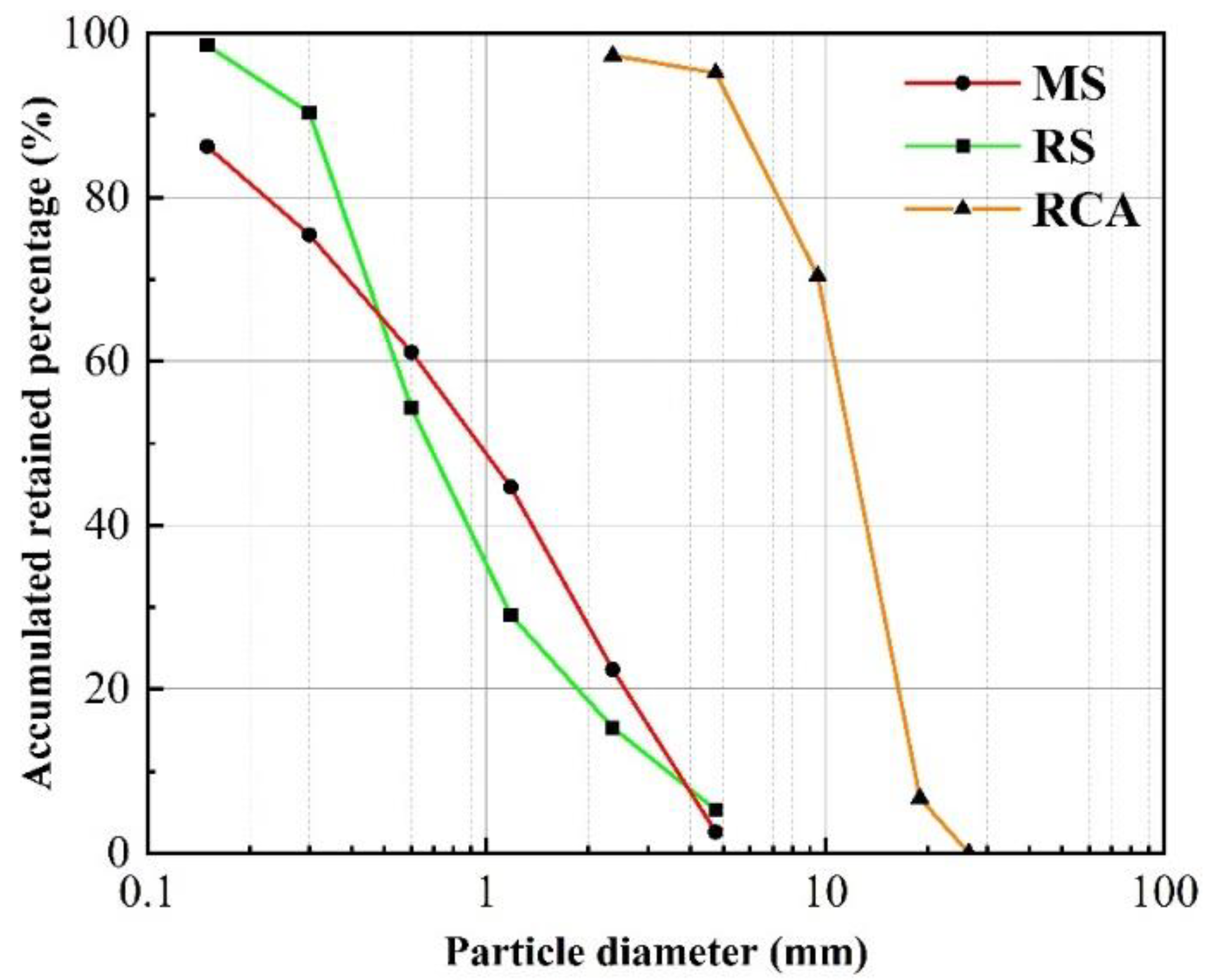

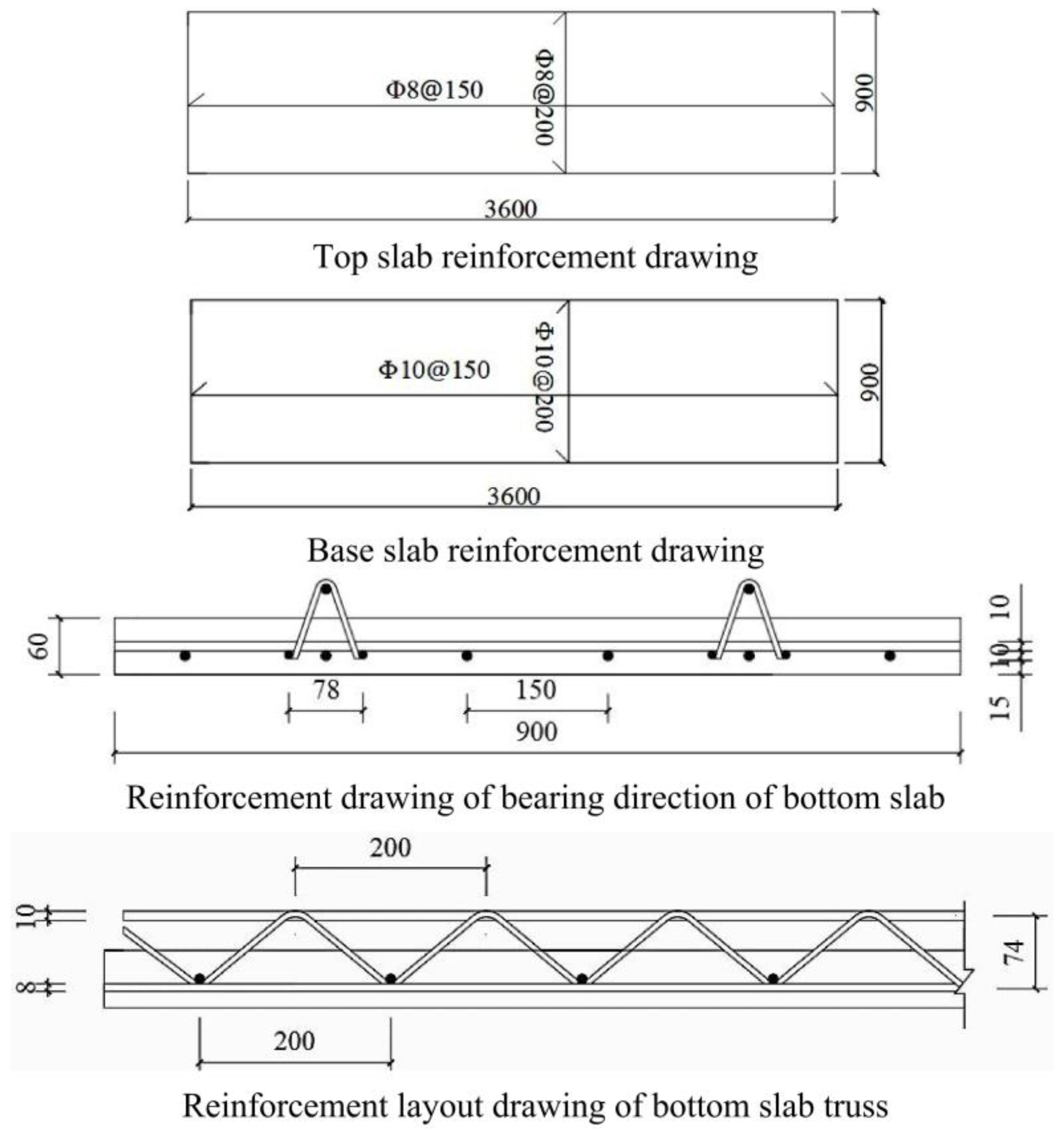

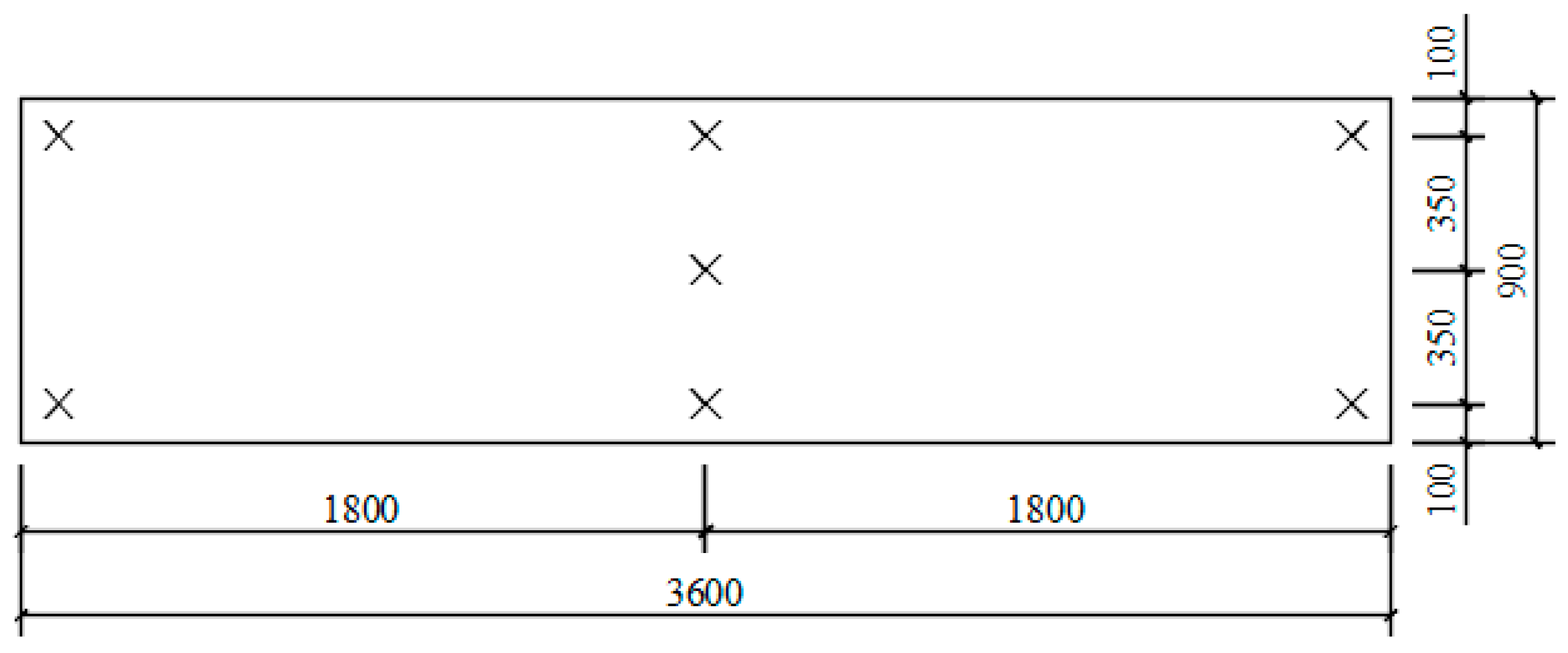
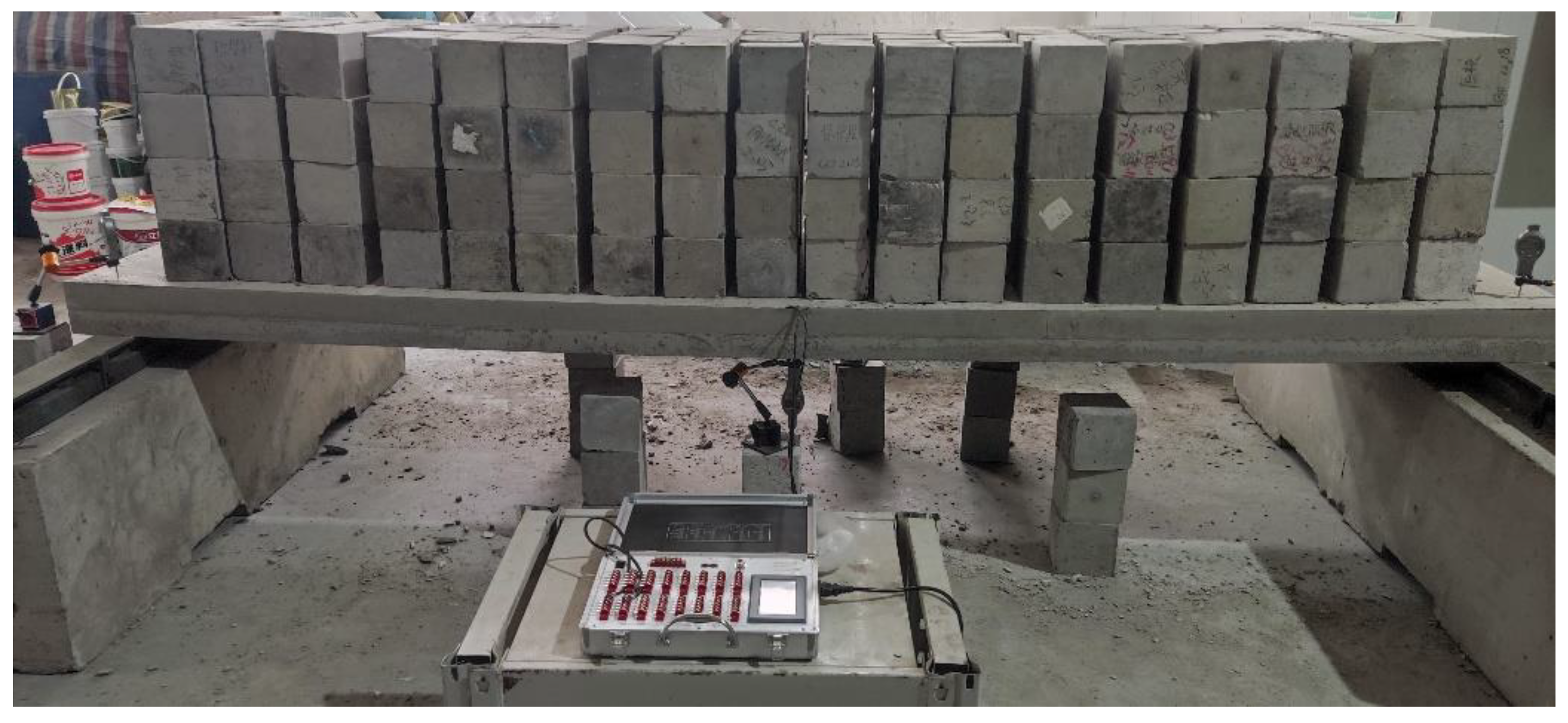
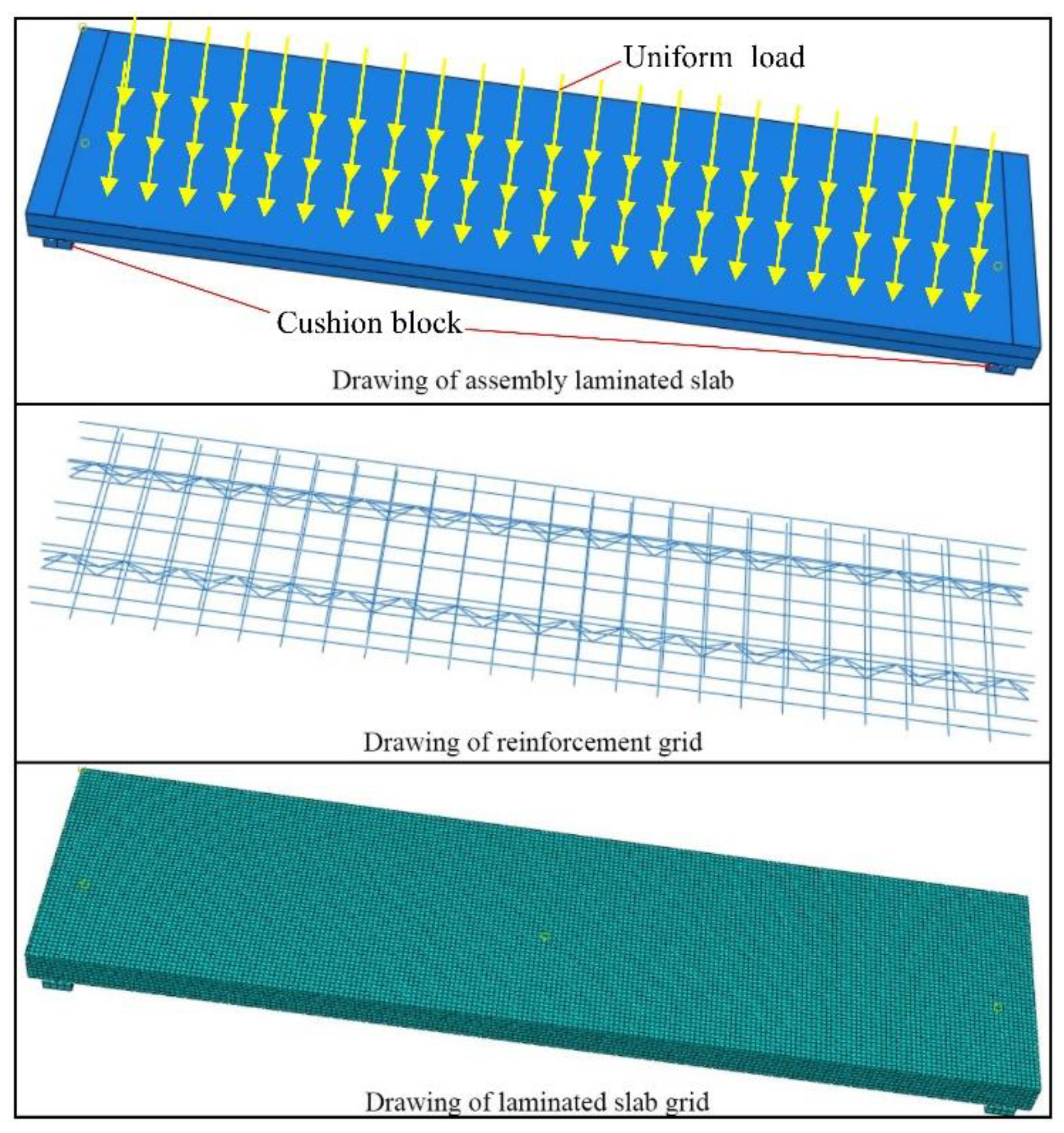


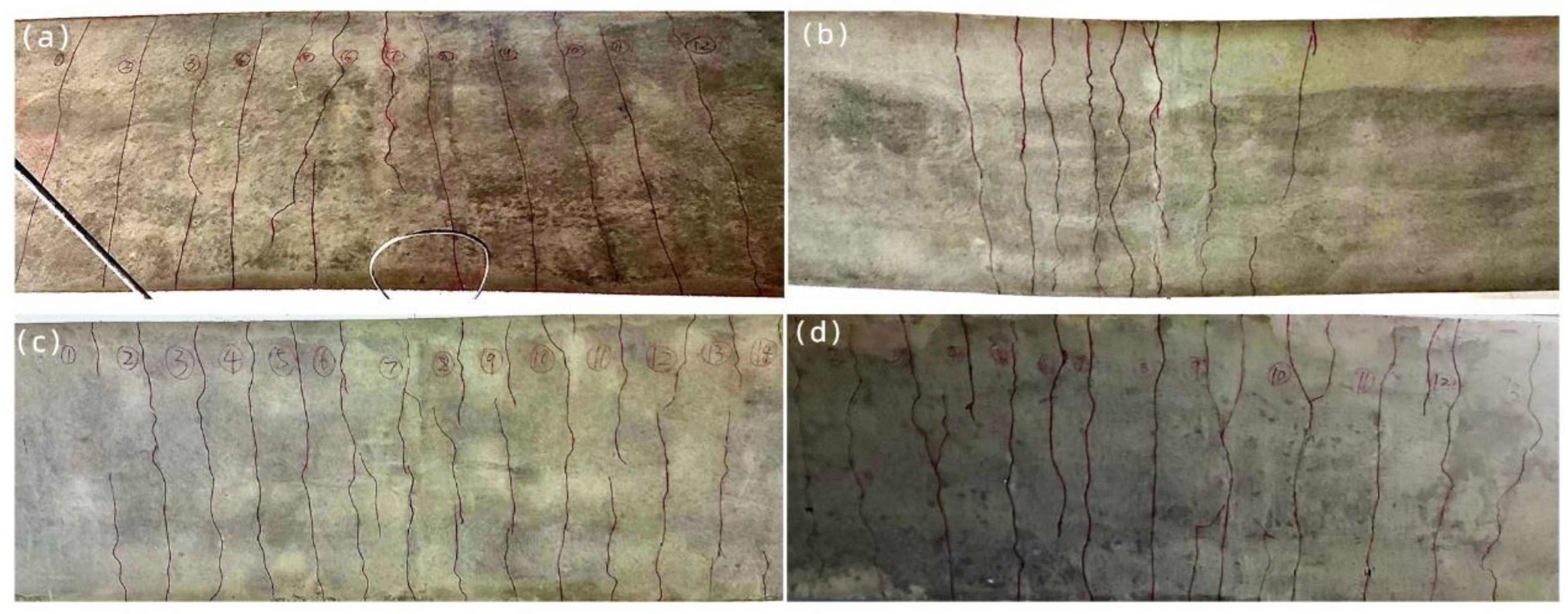

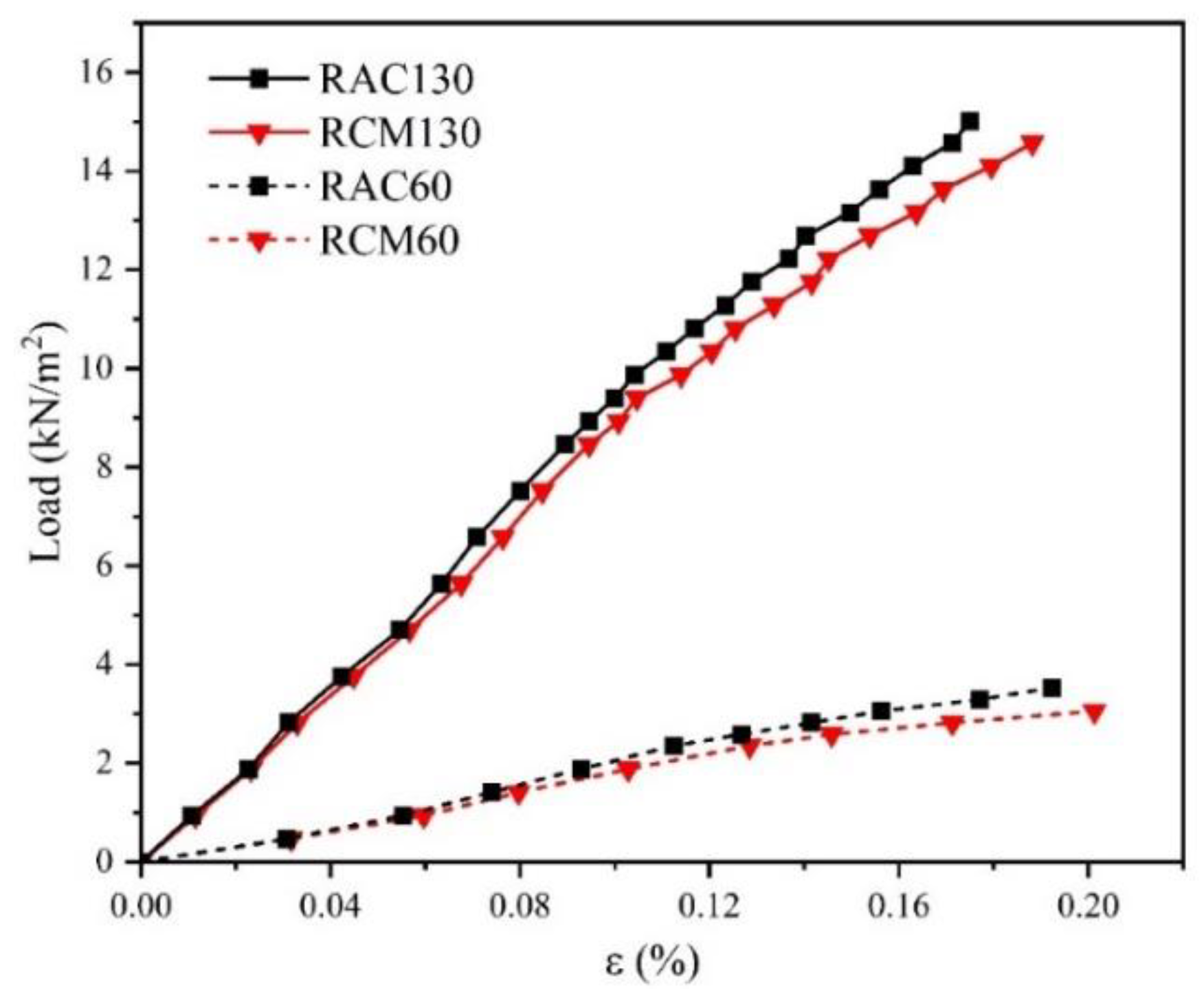
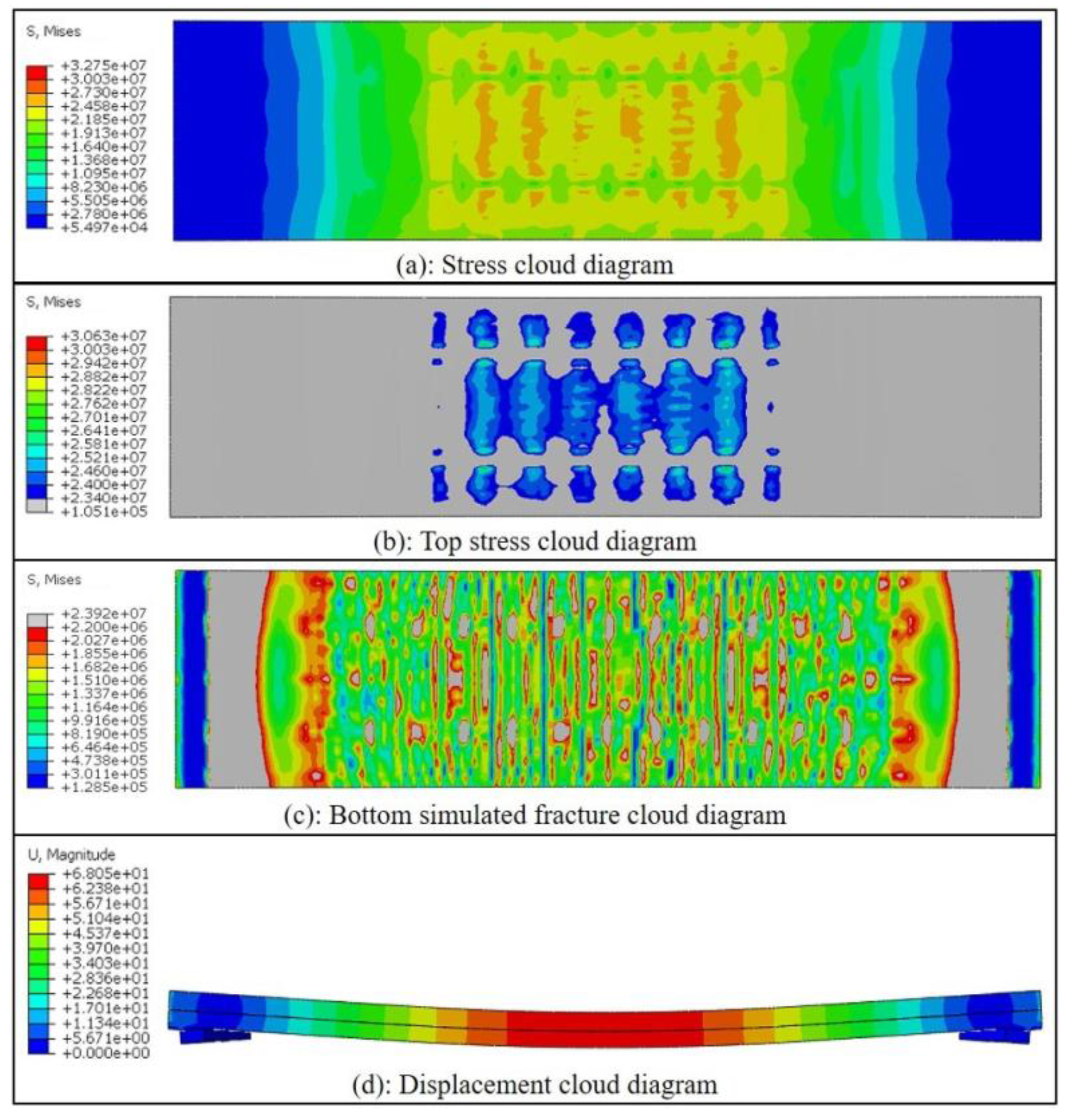
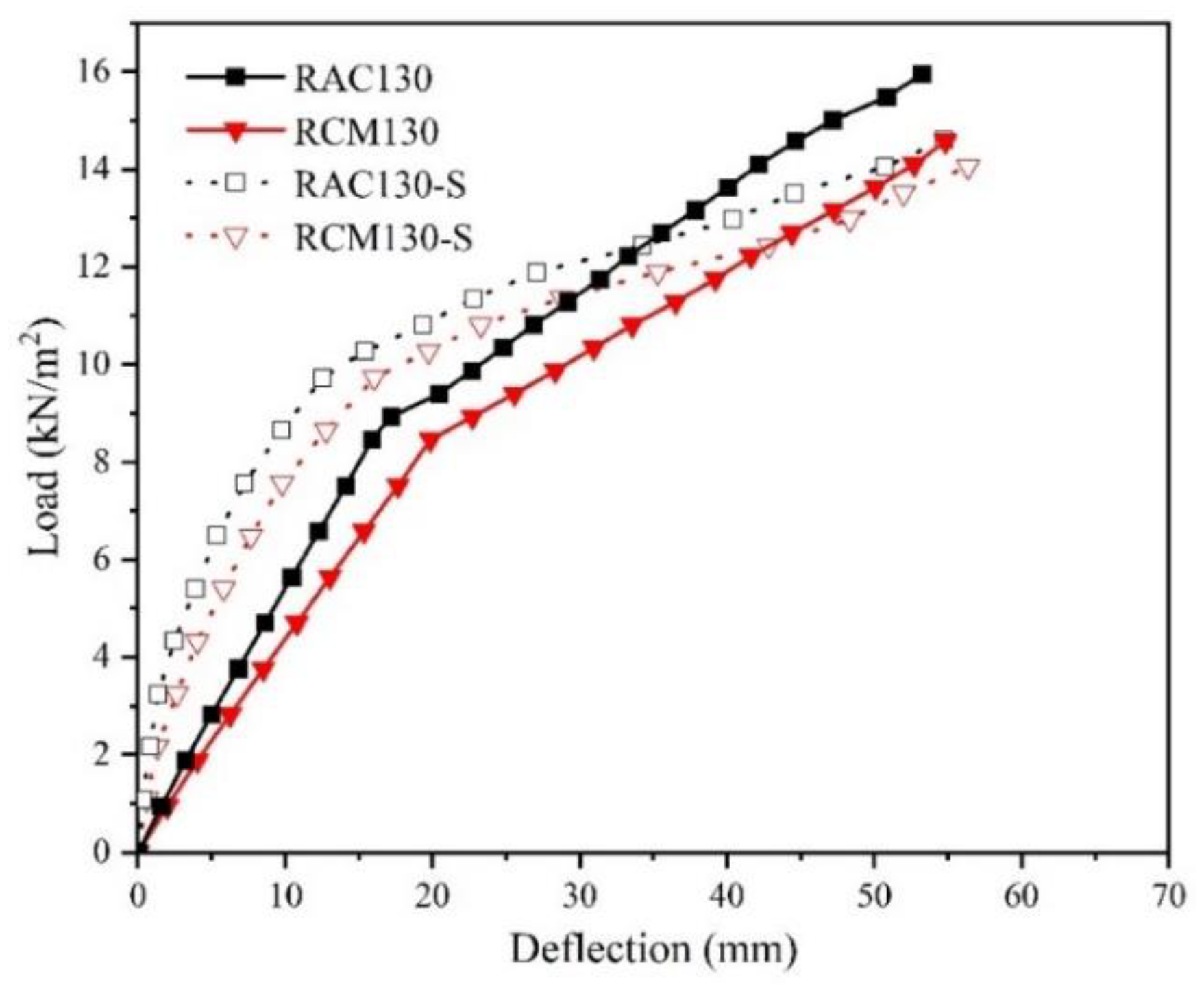
| Material | Mass Fraction/% | ||||||
|---|---|---|---|---|---|---|---|
| SiO2 | Al2O3 | Fe2O3 | TiO2 | CaO | MgO | Other | |
| Cement | 12.54 | 4.41 | 3.41 | 0.59 | 72.97 | 0.21 | 5.87 |
| Fly ash | 45.10 | 24.76 | 11.91 | 1.97 | 4.52 | 1.03 | 10.71 |
| Aggregate | Apparent Density (kg/m3) | Fineness Modulus | Crushing Value (%) | Fine Content (%) | MB Value | Water Absorption (%) |
|---|---|---|---|---|---|---|
| RCA | 2520 | / | 16.2 | / | / | 2.6 |
| RS | 2589 | 2.4 | 17.4 | / | / | / |
| MS | 2669 | 2.7 | 24.5 | 10.0 | 1.4 | 5.4 |
| Concrete | W/C | RCA | Fine Aggregate | Cement | FA | Additional Water | SP | |
|---|---|---|---|---|---|---|---|---|
| RS | MS | |||||||
| RCM1 | 0.42 | 926.05 | 0 | 754.04 | 303.07 | 101.02 | 32.7 | 2.02 |
| RAC1 | 0.42 | 926.05 | 733.99 | 0 | 303.07 | 101.02 | 16.3 | 2.02 |
| RCM2 | 0.48 | 907.96 | 0 | 773.21 | 287.28 | 95.76 | 32.1 | 1.92 |
| RAC2 | 0.48 | 907.96 | 752.64 | 0 | 287.28 | 95.76 | 16.1 | 1.92 |
| Type | Structural Composition | Size (mm) | Concrete Cover (mm) | Superimposed Surface Treatment |
|---|---|---|---|---|
| RCM60 | RCM1 | 3600 × 900 × 60 | 15 | / |
| RAC60 | RAC1 | 3600 × 900 × 60 | 15 | / |
| RCM130 | RCM1 precast base slab + RCM2 cast-in situ slab | 3600 × 900 × 130 | 15 | Roughening after initial setting |
| RAC130 | RAC1 precast base slab + RAC2 cast-in situ slab | 3600 × 900 × 130 | 15 | Roughening after initial setting |
| Type | Load in Elastic Stage (kN/m2) | Load in Elastic–Plastic Stage (kN/m2) | Failure Load (kN/m2) | Maximum Deflection (mm) | Maximum Crack Width (mm) |
|---|---|---|---|---|---|
| RAC60 | 0–2.35 | 2.35–3.53 | >3.76 | 60.36 | 0.45 |
| RCM60 | 0–1.88 | 1.88–2.82 | >3.06 | 61.25 | 0.51 |
| RAC130 | 0–8.46 | 8.46–15.01 | >15.95 | 53.26 | 1.19 |
| RCM130 | 0–7.52 | 7.52–14.10 | >15.01 | 54.84 | 1.25 |
Disclaimer/Publisher’s Note: The statements, opinions and data contained in all publications are solely those of the individual author(s) and contributor(s) and not of MDPI and/or the editor(s). MDPI and/or the editor(s) disclaim responsibility for any injury to people or property resulting from any ideas, methods, instructions or products referred to in the content. |
© 2024 by the authors. Licensee MDPI, Basel, Switzerland. This article is an open access article distributed under the terms and conditions of the Creative Commons Attribution (CC BY) license (https://creativecommons.org/licenses/by/4.0/).
Share and Cite
Huang, K.; Wang, X.; Wang, F.; Zhang, T. Mechanical Properties and Loading Simulation of Unidirectional Laminated Slabs Made from Recycled Concrete with Manufactured Sand. Buildings 2024, 14, 674. https://doi.org/10.3390/buildings14030674
Huang K, Wang X, Wang F, Zhang T. Mechanical Properties and Loading Simulation of Unidirectional Laminated Slabs Made from Recycled Concrete with Manufactured Sand. Buildings. 2024; 14(3):674. https://doi.org/10.3390/buildings14030674
Chicago/Turabian StyleHuang, Kailin, Xinjie Wang, Fajing Wang, and Tianrui Zhang. 2024. "Mechanical Properties and Loading Simulation of Unidirectional Laminated Slabs Made from Recycled Concrete with Manufactured Sand" Buildings 14, no. 3: 674. https://doi.org/10.3390/buildings14030674





